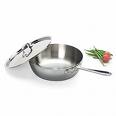After you have considered and stocked your kitchen with the basics, you can begin expanding your kitchen equipment. Your basics, the minimum one needs to cook a meal, include a cast-iron skillet, a baking dish and a medium-large saucepan. By medium-large, I was referring to something around 4-quart size. This was large enough to do rice, soups and stews, side dishes and even single servings of pasta.
When you feel you can afford a few more things in your Bachelor’s Kitchen, you should look for cookware that you might actually use or find almost a necessity. I call these the Kitchen Intermediates. Most of these items are going to be pot, pans, tools and maybe an appliance or two. Don’t get me wrong, I do like a good and useful appliance. But they can really clutter the kitchen, leaving you no room to cook when you want to. And I don’t like a bunch of them gathering dust in a closet or a rarely used cabinet.
It’s a saucepan; no, it’s a pot
Saucepans, also called pots, are sized by volume (how much liquid they hold). Usually, in the U.S., that’s in quarts. A saucepan usually has straight sides, flat bottom and a single handle. It may or may not have a lid. Some also have pour spouts. The difference between a saucepan and a pot is the number of handles. Pots usually have two handles close to the sides of the pot. Pans have single handles that extend away from the body of the pan. Some large pans have a small handle opposite the large one to make them easier to handle when full.
In addition to the medium-large saucepan, I recommend having at least one other size. A small saucepan, about one to one-and-a-half quart size, is very useful for warming single servings and for making some sauces and heating liquids. I use mine all the time. It’s perfect for heating broth when I make risotto.
It’s probably a good idea, when you can afford it, to get a range of sizes in saucepans with lids. But there’s no need to go overboard. Three or four pans will do for most jobs.
Curiously, the standard saucepan is not that good for making sauces. Two other types of pans are better suited. One is the lesser known Winsor pan, which has sloping sides. The other you’ve probably heard of — the saucier (pronounced saw-see-ay), which has rounded sides. These allow for better evaporation of liquids for reductions and more easily accommodate a whisk or spoon.
As you expand your kitchen knowledge and skills, a good set of saucepans are a good and useful addition to your equipment.




